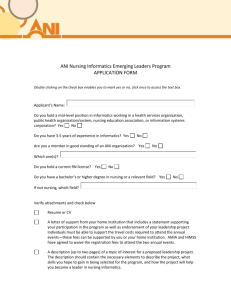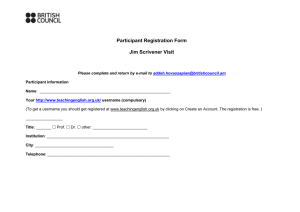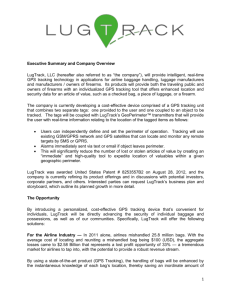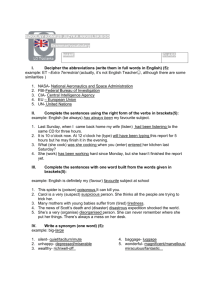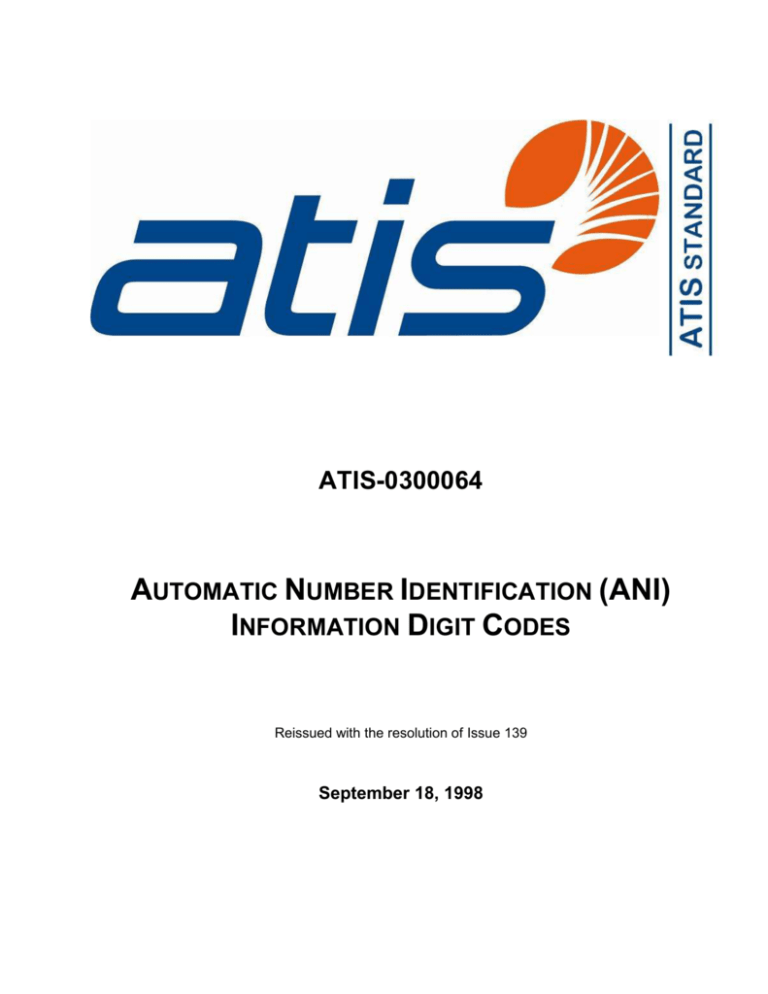
ATIS-0300064
AUTOMATIC NUMBER IDENTIFICATION (ANI)
INFORMATION DIGIT CODES
Reissued with the resolution of Issue 139
September 18, 1998
Copyright 1998 by the Alliance for Telecommunications Industry Solutions, Inc.
All rights reserved.
The ANI Information Digits Codes dated September 18, 1998 (former document number INC 98-0116-020) is
copyrighted, published and distributed by ATIS on behalf of the Industry Numbering Committee (INC). Except
as expressly permitted, no part of this publication may be reproduced or distributed in any form, including
electronic media or otherwise, without the prior express written permission of ATIS.
Participants in the INC and other parties are hereby authorized to reproduce this document and distribute it
within their own business organizations for business purposes, provided that this notice continues to appear in
the reproduced documentation. Resale is prohibited.
For ordering information, please contact:
ATIS
1200 G Street N.W., Suite 500
Washington, DC 20005
(202) 628-6380
inc@atis.org
A complete listing of INC Documents is available on the ATIS Web Site at: http://www.atis.org/inc/docs/.asp
ATIS is the leading technical planning and standards development organization
committed to the rapid development of global, market-driven standards for the
information, entertainment and communications industry.
More than 250
companies actively formulate standards in ATIS’ 18 Committees, covering issues
including: IPTV, Service Oriented Networks, Energy Efficiency, IP-Based and
Wireless Technologies, Quality of Service, and Billing and Operational Support. In
addition, numerous Incubators, Focus and Exploratory Groups address emerging
industry priorities including “Green”, IP Downloadable Security, Next Generation
Carrier Interconnect, IPv6 and Convergence.
ATIS is the North American Organizational Partner for the 3rd Generation
Partnership Project (3GPP), a member and major U.S. contributor to the
International Telecommunication Union (ITU) Radio and Telecommunications’
Sectors, and a member of the Inter-American Telecommunication Commission
(CITEL). For more information please visit < http://www.atis.org >.
------------------------------------------------------------------------------------------------------------------------------The Industry Numbering Committee (INC) provides an open forum to address and resolve industry-wide issues
associated with planning, administration, allocation, assignment and use of North American Numbering Plan
(NANP) numbering resources within the NANP area.
This document is maintained under the direction of ATIS and the INC. Suggestions for improvement of this
document are welcome. They should be sent to the Alliance for Telecommunications Industry Solutions, INC
Staff, 1200 G Street NW, Suite 500, Washington, DC 20005. All changes to this document shall be made
through the INC issue resolution process and adopted by the INC as set forth in the ATIS Operating Procedures.
-------------------------------------------------------------------------------------------------------------------Notice of Disclaimer & Limitation of Liability
The information provided in this document is directed solely to professionals who have the appropriate degree of
experience to understand and interpret its contents in accordance with generally accepted engineering or other
professional standards and applicable regulations. No recommendation as to products or vendors is made or
should be implied.
NO REPRESENTATION OR WARRANTY IS MADE THAT THE INFORMATION IS TECHNICALLY
ACCURATE OR SUFFICIENT OR CONFORMS TO ANY STATUTE, GOVERNMENTAL RULE OR
REGULATION, AND FURTHER, NO REPRESENTATION OR WARRANTY IS MADE OF MERCHANTABILITY
OR FITNESS FOR ANY PARTICULAR PURPOSE OR AGAINST INFRINGEMENT OF INTELLECTUAL
PROPERTY RIGHTS. ATIS SHALL NOT BE LIABLE, BEYOND THE AMOUNT OF ANY SUM RECEIVED IN
PAYMENT BY ATIS FOR THIS DOCUMENT, WITH RESPECT TO ANY CLAIM, AND IN NO EVENT SHALL
ATIS BE LIABLE FOR LOST PROFITS OR OTHER INCIDENTAL OR CONSEQUENTIAL DAMAGES. ATIS
EXPRESSLY ADVISES ANY AND ALL USE OF OR RELIANCE UPON THIS INFORMATION PROVIDED IN
THIS DOCUMENT IS AT THE RISK OF THE USER.
NOTE - The user’s attention is called to the possibility that compliance with this standard may require use of an
invention covered by patent rights. By publication of this standard, no position is taken with respect to whether
use of an invention covered by patent rights will be required, and if any such use is required no position is taken
regarding the validity of this claim or any patent rights in connection therewith.
ANI INFORMATION DIGITS CODES
ATIS-0300064
September 18, 1998
Page 2 of 10
__________________________________________________________________________________________________
TABLE OF CONTENTS
Section
Page
1.0
INTRODUCTION
5
2.0
ANI INFORMATION DIGITS CODES
5
ANI INFORMATION DIGITS CODES
ATIS-0300064
September 18, 1998
Page 3 of 10
__________________________________________________________________________________________________
1. Introduction
The following table lists and defines ANI Information Digits Codes which are assigned by
the North American Numbering Plan Administration (NANPA) at the request of the Industry
Numbering Committee (INC). The assignment of ANI II Digits does not imply their
ubiquitous availability. The availability of ANI II Digits should, therefore, be confirmed with
any given service provider.
2. ANI Information Digits Codes
DIGITS
DESCRIPTION
00
Plain Old Telephone Service (POTS) - non-coin service requiring no special
treatment
01
Multi-party line (more than 2) - ANI cannot be provided on 4 or 8 party lines.
The presence of this “01” code will cause an Operator Number Identification
(ONI) function to be performed at the distant location. The ONI feature routes
the call to a CAMA operator or to an Operator Services System (OSS) for
determination of the calling number.
02
ANI Failure - the originating switching system indicates (by the “02” code), to
the receiving office that the calling station has not been identified. If the
receiving switching system routes the call to a CAMA or Operator Services
System, the calling number may be verbally obtained and manually recorded.
If manual operator identification is not available, the receiving switching system
(e.g., an interLATA carrier without operator capabilities) may reject the call.
03-05
06
Unassigned
Station Level Rating - The “06” digit pair is used when the customer has
subscribed to a class of service in order to be provided with real time billing
information. For example, hotel/motels, served by PBXs, receive detailed
billing information, including the calling party’s room number. When the
originating switching system does not receive the detailed billing information,
e.g., room number, this “06” code allows the call to be routed to an operator or
operator services system to obtain complete billing information. The rating
and/or billing information is then provided to the service subscriber. This code
is used only when the directory number (DN) is not accompanied by an
automatic room/account identification.
ANI INFORMATION DIGITS CODES
ATIS-0300064
September 18, 1998
Page 4 of 10
__________________________________________________________________________________________________
DIGITS
DESCRIPTION
07
Special Operator Handling Required - calls generated from stations that require
further operator or Operator Services System screening are accompanied by the “07”
code. The code is used to route the call to an operator or Operator Services System
for further screening and to determine if the station has a denied-originating class of
service or special routing/billing procedures. If the call is unauthorized, the calling
party will be routed to a standard intercept message.
08-09
Unassigned
10
Not assignable - conflict with 10X test code
11
Unassigned
12-19
20
21-22
23
Not assignable - conflict with international outpulsing code
Automatic Identified Outward Dialing (AIOD) - without AIOD, the billing number
for a PBX is the same as the PBX Directory Number (DN). With the AIOD
feature, the originating line number within the PBX is provided for charging
purposes. If the AIOD number is available when ANI is transmitted, code “00”
is sent. If not, the PBX DN is sent with ANI code “20”. In either case, the
AIOD number is included in the AMA record.
Unassigned
Coin or Non-Coin - on calls using database access, e.g., 800, ANI II 23 is used
to indicate that the coin/non-coin status of the originating line cannot be
positively distinguished for ANI purposes by the SSP. The ANI II pair 23 is
substituted for the II pairs which would otherwise indicate that the non-coin
status is known, i.e., 00, or when there is ANI failure.
ANI II 23 may be substituted for a valid 2-digit ANI pair on 0-800 calls. In all
other cases, ANI II 23 should not be substituted for a valid 2-digit ANI II pair
which is forward to an SSP from an EAEO.
Some of the situations in which the ANI II 23 may be sent:
• Calls from non-conforming end offices (CAMA or LAMA types) with
combined coin/non-coin trunk groups.
• 0-800 Calls
• Type 1 Cellular Calls
• Calls from PBX Trunks
• Calls from Centrex Tie Lines
ANI INFORMATION DIGITS CODES
ATIS-0300064
September 18, 1998
Page 5 of 10
__________________________________________________________________________________________________
DIGITS
DESCRIPTION
24
Code 24 identifies a toll free service that has been translated to a Plain Old
Telephone Service (POTS) routable number via the toll free data base that
originated for any non-pay station. If the received toll free number is not
converted to a POTS number, the data base returns the received ANI code
along with the received toll free number. Thus, this 24 code indicates that this
is a toll free service call since that fact can no longer be recognized simply by
examining the called address.
25
Code 25 identifies a toll free service call that has been translated to a Plain Old
Telephone Service (POTS) routable number via the toll free data base that
originated from any pay station, including inmate telephone service.
Specifically, ANI II digits 27, 29 and 70 will be replaced with Code 25.
26
Unassigned
27
Code 27 identifies a line connected to a pay station which uses network
provided coin control signaling. II 27 is used to identify this type of pay station
line irrespective of whether the pay station is provided by a LEC or a non-LEC.
II 27 is transmitted from the originating end office on all calls made from these
lines.
28
Unassigned
29
Code 29 is used to identify lines serving a confinement/detention facility that
are intended for inmate/detainee use and require outward call screening (e.g.,
0+ collect only service). As per Sect. 276 (d) of the Telecom Act, inmate
telephone service is considered to be included in the general category of
payphone service. Accordingly, lines identified with ANI II 29 include both
prison/inmate phones/payphones.
ANI INFORMATION DIGITS CODES
ATIS-0300064
September 18, 1998
Page 6 of 10
__________________________________________________________________________________________________
DIGITS
DESCRIPTION
30-32
Intercept - where the capability is provided to route intercept calls (either
directly or after an announcement recycle) to an access tandem with an
associated Telco Operator Services System, the following ANI codes should
be used:
30 Intercept (blank) - for calls to unassigned directory number (DN)
31 Intercept (trouble) - for calls to directory numbers (DN) that have been
manually placed in trouble-busy state by Telco personnel
32 Intercept (regular) - for calls to recently changed or disconnected numbers
33
Unassigned
34
Telco Operator Handled Call - after the Telco Operator Services System has
handled a call for an IC, it may change the standard ANI digits to “34”, before
outpulsing the sequence to the IC, when the Telco performs all call handling
functions, e.g., billing. The code tells the IC that the BOC has performed
billing on the call and the IC only has to complete the call.
35-39
Unassigned
40-49
Unrestricted Use - locally determined by carrier
50-51
Unassigned
52
53-59
Outward Wide Area Telecommunications Service (OUTWATS) - this service
allows customers to make calls to a certain zone(s) or band(s) on a direct
dialed basis for a flat monthly charge or for a charge based on accumulated
usage. OUTWATS lines can dial station-to-station calls directly to points within
the selected band(s) or zone(s). The LEC performs a screening function to
determine the correct charging and routing for OUTWATS calls based on the
customer’s class of service and the service area of the call party. When these
calls are routed to the interexchange carrier via a combined WATS-POTS
trunk group, it is necessary to identify the WATS calls with the ANI code “52”.
Unassigned
ANI INFORMATION DIGITS CODES
ATIS-0300064
September 18, 1998
Page 7 of 10
__________________________________________________________________________________________________
DIGITS
DESCRIPTION
60
TRS - ANI II digit pair 60 indicates that the associated call is a TRS call
delivered to a transport carrier from a TRS Provider and that the call originated
from an unrestricted line (i.e., a line for which there are no billing restrictions).
Accordingly, if no request for alternate billing is made, the call will be billed to
the calling line.
61
Cellular/Wireless PCS (Type 1) - The “61” digit pair is to be forwarded to the
interexchange carrier by the local exchange carrier for traffic originating from a
cellular/wireless PCS carrier over type 1 trunks. (Note: ANI information
accompanying digit pair “61” identifies only the originating cellular/wireless
PCS system, not the mobile directory placing the call.
62
Cellular/Wireless PCS (Type 2) - The “62” digit pair is to be forwarded to the
interexchange carrier by the cellular/wireless PCS carrier when routing traffic
over type 2 trunks through the local exchange carrier access tandem for
delivery to the interexchange carrier. (Note: ANI information accompanying
digit pair “62” identifies the mobile directory number placing the call but does
not necessarily identify the true call point of origin.)
63
Cellular/Wireless PCS (Roaming) - The “63” digit pair is to be forwarded to the
interexchange carrier by the cellular/wireless PCS subscriber “roaming” in
another cellular/wireless PCS network, over type 2 trunks through the local
exchange carrier access tandem for delivery to the interexchange carrier.
(Note: Use of “63” signifies that the “called number” is used only for network
routing and should not be disclosed to the cellular/wireless PCS subscriber.
Also, ANI information accompanying digit pair “63” identifies the mobile
directory number forwarding the call but does not necessarily identify the true
forwarded-call point of origin.)
64-65
Unassigned
66
TRS - ANI II digit pair 66 indicates that the associated call is a TRS call
delivered to a transport carrier from a TRS Provider, and that the call originates
from a hotel/motel. The transport carrier can use this indication, along with
other information (e.g., whether the call was dialed 1+ or 0+) to determine the
appropriate billing arrangement (i.e., bill to room or alternate bill).
DIGITS
DESCRIPTION
67
TRS - ANI II digit pair 67 indicates that the associated call is a TRS call
ANI INFORMATION DIGITS CODES
ATIS-0300064
September 18, 1998
Page 8 of 10
__________________________________________________________________________________________________
delivered to a transport carrier from a TRS Provider and that the call originated
from a restricted line. Accordingly, sent paid calls should not be allowed and
additional screening, if available, should be performed to determine the
specific restrictions and type of alternate billing permitted.
68-69
70
Unassigned
Code 70 identifies a line connected to a pay station (including both coin and
coinless stations) which does not use network provided coin control signaling.
II 70 is used to identify this type pay station line irrespective of whether the pay
station is provided by a LEC or a non-LEC. II 70 is transmitted from the
originating end office on all calls made from these lines.
71-79
Unassigned
80-89
Reserved for Future Expansion “to” 3-digit Code
90-92
Unassigned
93
Access for private virtual network types of service: the ANI code “93” indicates,
to the IC, that the originating call is a private virtual network type of service call.
94
Unassigned
95
Unassigned - conflict with Test Codes 958 and 959
96-99
Unassigned


